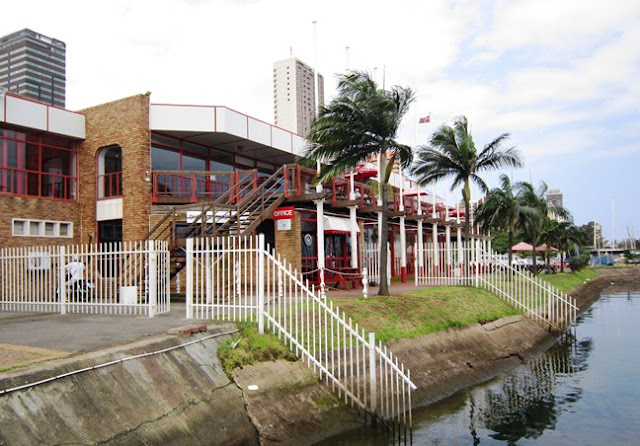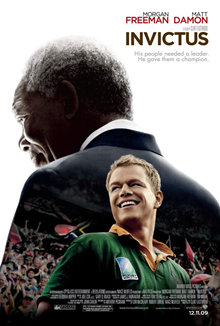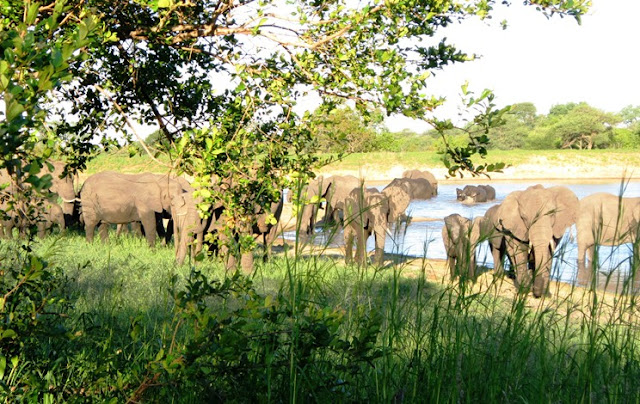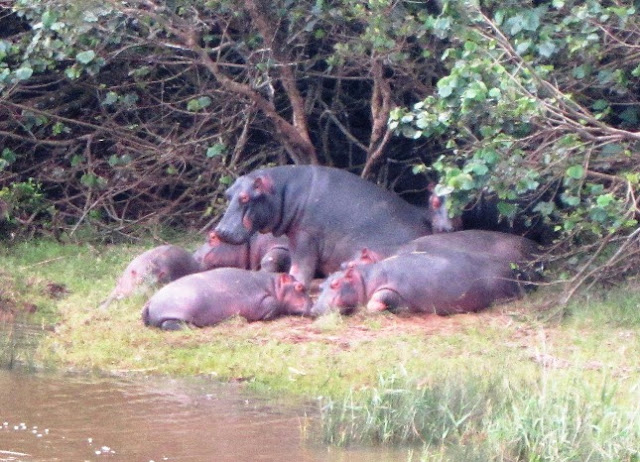We got a good forecast and left Richards Bay one lovely morning. There was almost no wind in the harbour and the forecast was for slowly building winds from useful directions (moving to northeast). The only problem was that the weather had not read the forecast and there were still SW winds in the 15 knot range. These followed the 30+ knot squall we got just as we left the harbour. In any case, after making very slow progress into the swell and wind (motoring) we decided that discretion is the better part of whatever and had a very nice sail back for an hour or so.
Next morning, we tried again and the conditions were right for heading SW. It looked like the weather window would be long enough to skip Durban and go all the way to East London. After a few hours we found the Agulhas Current which you try to ride southwest. Our highest speed was 12.4 knots and we averaged more than 10 knots for four hours at one point when we probably sailing about 7 knots. All
| Here is a typical current chart for the eastern part of the South African coast. The Mozambique border is at the top and East London at the bottom. The brighter the colour the faster the current. There are areas with currents greater than 3.5 knots in the area between Richards Bay and Durban. What you want to do is stay in an area of fast current but not be too far away from the coast so you can close to shore if the winds swing to the southwest since in these conditions you can get enormous, dangerous waves - the guides talk about 20 m. In general, the suggestion is to follow the 200 m depth contour, although we found that good currents seemed to start at around 100 m. Note that the current pattern is constantly changing.
Once we got opposite Durban our joy dissipated when we got a new forecast that closed the weather window about 12 hours sooner than we expected and we were going to be about 70 miles from East London when the winds switched (in our limited experience it seems that the forecasts over-estimate the length of windows). No problem, we would just have to go to Durban until the next window. Unfortunately we were about 24 miles offshore at this point and had a long way to go in.
Our stay in Durban, at the Point Yacht Club, turned out to be much longer than we expected as you shall see. At first it seemed like a short stop and we left as the weather window was opening. We were only about two miles from the harbour entrance in 25 to 30 knots from the SE with a nasty left over job when the fitting that held our lower shrouds to the mast sheared off and it, along with the two lower shrouds fell onto the deck. Needless to say this focussed our attention since my first thought was that we could lose the mast. We quickly tacked to put the load on the shrouds on the other side and rigged the two running backstays (strong, hi-tech lines that are attached to the mast above the shrouds) to provide extra support for the mast and headed back. To be fair, the mast did brilliantly and even at the worst moment it did not appear like it was going to fail. Hail to Ted Hood and Bristol. It is like a stout tree. I think a lot of boats would have lost their rig with this failure. On the way back into the harbour we called a 1000 foot container ship and explained the problem and asked if we could go in first. The pilot was most helpful, told us to cross his bows and enter down the north side of the channel with him coming a bit to the south in the narrow channel.
We had a number of repairs to do somewhere and decided to do them in Durban rather than later since we had to fix the mast fitting in any case . This turned out to be a good idea since we found out that many businesses in SA close a week or so before Christmas and stay closed for three weeks or more. The mmast fitting turned out to be the easiest thing of all. There is a small store near the harbour called Cruising Connections run by Tony Herrick. He sells mainly used stuff including charts and various boat fittings. Included is a 'junk box' of stainless fittings that he sells by weight. In this box was a fitting exactly as we needed. In this one, the two plates had been welded together at the top which seems like a good idea. With the old one the two plates were loose and just held together by the nuts on the threaded rod through the mast. The only problem was that the two lower holes had to be drilled out a bit to fit our shrouds, the large top hole was already the right size. We got the local rigger to make up a new shroud to replace one with a broken wire strand in it (the number of boats that arrive in SA with one or more broken shrouds is very large indeed) and to drill out the two holes. That was fine except he only drilled out one hole and was just heading off on holiday to Mozambique and closed his shop for the holidays. He arranged for a very helpful guy who ran the boatyard at the marina to drill it, but he did not have the right drill. Finally he got one and did the drilling which took about one minute. We took our outboard and inflatable to get serviced on Wednesday (after calling and being told they could do the work within a couple of days) and they assured us that they would be fixed no problem. BTW, we had to rent a car and drive almost an hour to find these guys in the hills north of the city. We called Friday and they said they were working Saturday and it would be ready for Tuesday (Monday was a holiday - these guys have almost as many holidays as the Aussies). We rented a car and went to pick them up on Tuesday and they had not even looked at them and did not know when they could get to them.The owner did not even have the courtesy to talk to us and sent one of his underlings who seemed like a very nice guy, but far too willing to promise what he could not deliver. We loaded everything up and headed back to the city. If you are in Durban and name 'Gary's Water Sports' comes into the discussion - run away. I think what it comes down to is that Gary knew that we would only every be there once and he wanted to focus on the local customers before the holiday - which he could and should have told us in the first place. Note for cruisers, I sent an email to Noonsite suggesting that this guy's company be delisted. We also took our SSB radio in to a company called Imtech which is part of Holland Radio. They provide electronic servicing for ships all over the world. I wanted to get the HAM frequencies on the radio unblocked since I got my HAM license when I was last in Canada (VE3 CCV) and also have the radio reprogrammed so I can transmit on marine data channels. They said they had the manuals to do this and it would not be a problem. Two hours of expensive labour later, nothing had changed and they did not know what else to try, so the radio went back on the boat unchanged. Do I appear happy with getting things fixed in Durban? I doubt it. While we were in Durban we went to a Christmas concert in the Botanic Garden featuring Ladysmith Black Mambazo. They are most famous for their collaboration with Paul Simon the Graceland album that was the top album in the world 27 years ago (hard to believe its been that long). Since then they have remained prominent and have won three Grammy awards and performed at the soccer world cup and at the ceremonies when Nelson Mandela was awarded the Nobel Peace Prize. They and their opening group only did a couple of Christmas songs, but that was irrelevant in the enjoyment of the evening. There were about a thousand people at the concert and we were sitting on the grass about 5 m from the stage so we could see and here everything. Most agreeable evening Here is the first audio link on the blog. It is to an interesting song and video. Shosholoza seems to be like an informal second national anthem . It was performed as the encore to the performance we saw and certainly got a lot of people up and dancing. The video ties together the song, the national rugby team and its symbol, the Springbok which is a type of antelope that lives in dry areas of the country. At the end of the video there is a statement about losing the Springbok as a symbol - no idea what that is all about. There have been a lot of politics associated with rugby. (Background with a bit of a simplification but here goes), traditionally rugby has been associated most with the Afrikaans population, while cricket has been the English game, and soccer the black game. Black South Africans had traditionally not cheered for the Springboks because they were a major symbol of their oppressors. Among the Afrikaaners in particular, the game is almost like a religion. Games between the Springboks and the Kiwis and Springboks and Aussies are incredibly important. There is even a 'super' rugby league that has teams in the three countries. Think hockey in Canada for a comparison. In 1995, shortly after the end of Apartheid, South Africa hosted and participated in its first world cup (they were banned from previous world cups because of Apartheid). Nelson Mandela, being Nelson Mandela. made a big point out going to the games and rallying all the people behind their almost entirely white team (with one black player). Hosting and winning this tournament made a major contribution to the growth of the new, 'rainbow' nation, although there is still much, much more to do. Shosholoza by Ladysmith Black Mambazo The port of East London is actually in a river, the only one in South Africa. We were only there for about 27 hours at anchor. We got a forecast that suggested we could get to Port Elizabeth overnight, but that we would have to motor since winds would be light. Accordingly we left the harbour at about 7 pm and had to deal with quite a bit of fog until we reached warmer waters offshore. I am sure that there are nice mathematical solutions to the problem but it was never entirely clear at what angle you should leave the shore to get into the current in the most effective manner. Do you go straight out to reach the current as soon as possible or do you go at an angle so you are moving towards your destination at the same time you are heading out. We sort of went at a 45 to 55 degree angle. A second question is how far out to go. If you are at a point where you are getting 2.5 knots of help is it worth going offshore for another hour to try to get 3.5? We used satisficing behaviour (yes, there is such a word, I was thinking about doing a doctoral dissertation on satisficing wrt school textbooks), rather than optimizing and followed the 100 m contour pretty much and generally were going between 8 and 9 knots. It was an interesting experience. You had to keep an eye on the boat speed, the water depth and the water temperature. At one point the water temp dropped 0.5C and the depth went from just over 100 m to about 90 m and boat slowed by about a knot. We angled out for about five minutes and recovered speed,, depth, and temperature. We left EL with another boat that could motor faster than we can, but they stayed within four miles of shore while we were 8 to 10 miles off. We arrived in PE an hour before they did even though we went further. We saw lots of interesting wildlife on the way to PE with several whales, a large shark on the surface, some seals, a lot of large sea birds and even many African penguins. |




































































